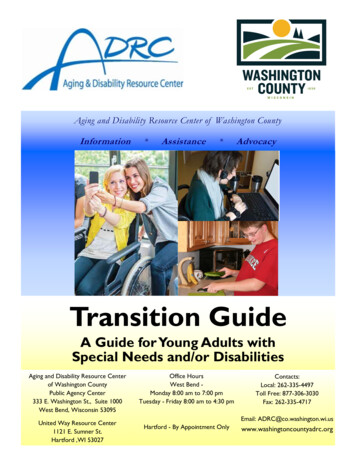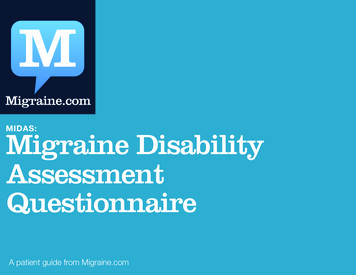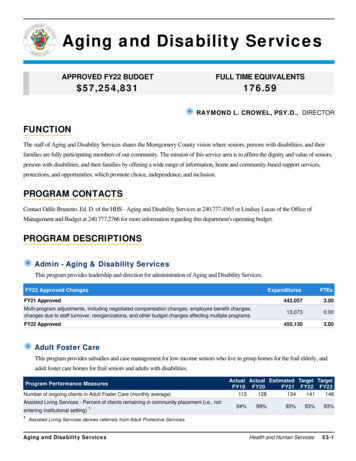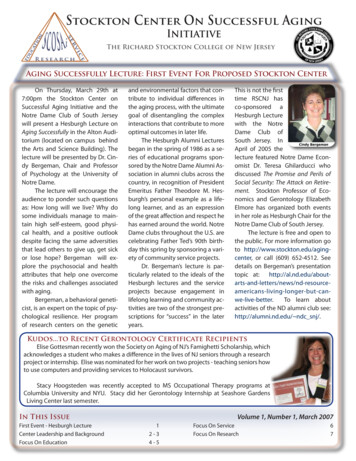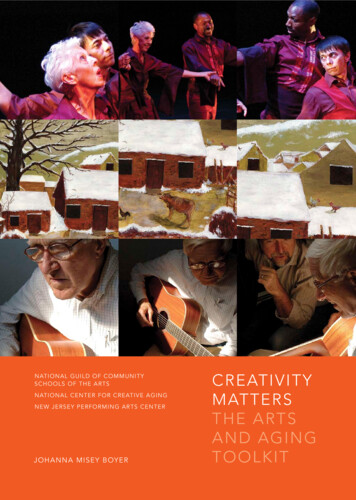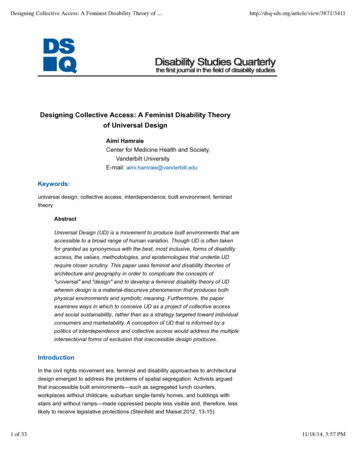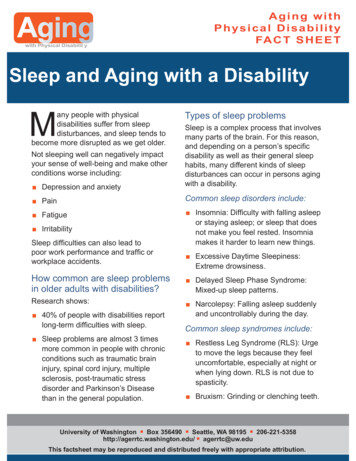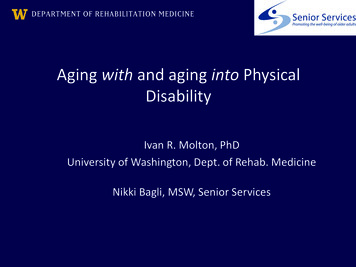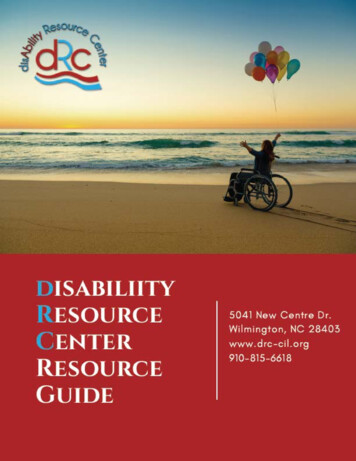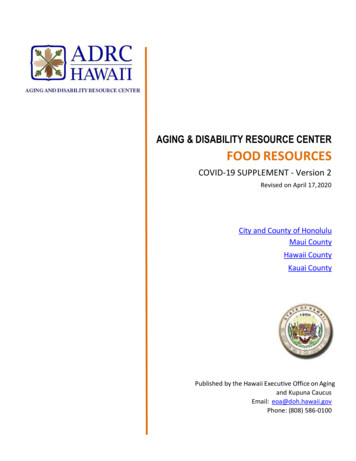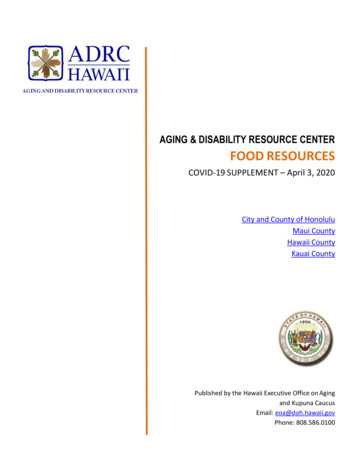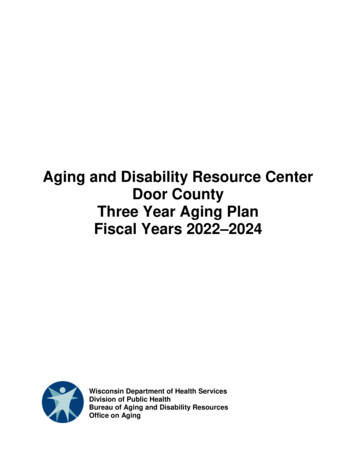
Transcription
Aging and Disability Resource CenterDoor CountyThree Year Aging PlanFiscal Years 2022–2024Wisconsin Department of Health ServicesDivision of Public HealthBureau of Aging and Disability ResourcesOffice on Aging
ADRC Mission Statement: The Aging and Disability Resource Center ofDoor County offers a friendly, personal and timely approach to providinginformation, assistance and access to community resources. The goal is tokeep the citizens of the county active and engaged in their own well-beingand within their communities.ADRC’s Core Values: Consumer-Driven Services: We will support individual choice builton the strength of individuals, families and their communities. Empowerment: We will equip persons with the tools they need tomake informed decisions and maintain control of their lives. Respect: We will recognize and value the unique qualities andexperience of each person. Inclusion: We provide unbiased services to all races, ethnicities,gender identities, sexual orientations and religions. Quality: We will continuously strive to provide the highest qualityservices. Collaboration: We will promote partnerships that reach acrosssystems and organizational boundaries. Stewardship: We will effectively & efficiently manage public andprivate resources.2
Table of ContentsIntroduction . . Page 4Executive Summary . Page 5Context . Page 8Current Landscape . Page 8Population Trends . . Page 8Racial and Ethnicity Diversity . . . . .Page 10Dementia . . .Page10Financial Insecurity . .Page 11Identified Needs Page 12Door County Aging Network . . Page 14Resources and Partnerships . .Page 15Future Implications . .Page 16Long Path Vision . .Page 17Community Involvement in the Development of the Aging Plan . . Page 17Public Hearing Requirements . Page 17Goals for the Plan Period . Page 18Coordination Between Title III and Title VI . .Page 29Organization, Structure and Leadership of the Aging Unit .Page 30Primary Contact to Respond to Questions About the Aging Plan . Page 30Organizational Chart of the Aging Unit . . Page 31Staff of the Aging Unit .Page 32Aging Unit Coordination with ADRCs . . . Page 35Statutory Requirements for the Structure of the Aging Unit . . .Page 36Role of the Policy-Making Body . . .Page 37Membership of the Policy-Making Body . . .Page 37Role of the Advisory Committee . . .Page 38Membership of the Advisory Committee . . .Page 38Budget Summary . . . Page 40Verification of Intent . .Page 40Assurances of Compliance with Federal and State Laws and Regulations. . .Page 41Compliance with Federal and State Laws and Regulations for 2022-2024.Page 41Appendices . . .Page 56Attachment 1: Community Input Report - ADRC Questionnaire .Page 56Attachment 2: ADRC Questionnaire . . Page 58Attachment 3: Community Input Report - Listening Sessions .Page 603
IntroductionThe Aging and Disability Resource Center (ADRC) of Door County provides acentralized location and starting point for anyone seeking information and support onissues affecting older adults, adults living with a physical, developmental and intellectualdisability, their caregivers and families. The information and support in connecting tocommunity resources is unbiased and free. Services are provided over the phone, in anoffice visit, or in a visit to an individual’s home. We also provide after-hour appointmentswhen requested or necessary.We support the community through our information and assistance services, long termcare options counseling, benefit specialist services, family caregiver support programs,fall prevention efforts, hot and frozen home delivered meals, congregate and carryoutmeals located at five different meal sites throughout the county, volunteer and socialopportunities and health promotion programs. Throughout all of our programs andservices, our overall goal is to help empower and support individuals in remaining activeparticipants in family and community life.Every three years, the ADRC is required by the State of Wisconsin’s Bureau of Agingand Disability Resources (BADR) to complete a strategic plan that serves as a platformto develop, improve and expand services we provide our community. This livingdocument is known as our “Three Year Aging Plan” and the new plan will cover years2022-2024. We are pleased to present our plan and the goals we have designated aspriorities in order to help support older adults, adults living with a physical,developmental and intellectual disability, their families and caregivers living here in DoorCounty.Our three-year aging plan was built on public feedback from older adults and adultsliving with a disability and their families, input from ADRC and Nutrition AdvisoryCommittee members, a review of the current service delivery challenges and populationtrends. As we look forward to the next three years in providing services this plan willprovide us the direction needed to stay focused on improving the quality of life for thosewe serve here in our community.4
Executive SummaryThroughout the past few years, prior to the COVID-19 pandemic, the Aging andDisability Resource Center (ADRC) of Door County experienced a great deal oftransformation and growth. The most exciting change occurred back in January of 2018when we moved into a brand-new building that is four times bigger than our previousone. The move to the new building has had an unbelievable impact on our entireorganization and also provided an excellent opportunity to fully complete the integrationprocess of our Aging Unit (more commonly known as the Senior Center) with theADRC.We are very proud of the new building and the overall enhancement that it has meant toour agency as well as our community. The additional space has allowed our ADRC theability to meet an even greater public need than ever before. We have seen atremendous amount of exposure and participation within all of our programs throughoutour entire organization. Listed below are just some of the successes we haveexperienced since the move to our new building. Nutrition Program: Throughout 2017 (last year of operation in the old building),we served just over 35,000 meals. This includes our frozen, hot home deliveredand congregate meals. After the move to the new building we now serve onaverage 10,000 more meals a year totaling about 45,000 meals annually. Withthe Sturgeon Bay meal site experiencing the largest increase in dailyparticipation. On average in 2017 we were serving roughly 44 congregate mealsa day at the Sturgeon Bay meal site. And since the move our average increasedto roughly 80 congregate meals a day. Total Activity/Program Participation: For every activity and event that weprovide at the ADRC we track participation through our Schedules Plus check-insoftware system. These activities, programs and events are the ones you seelisted in our monthly newsletters. Before the move in 2017, we had a totalnumber of 686 unduplicated individuals participate 12,413 times in our activities,programs and events. Throughout 2019, pre-COVID-19 pandemic, our totalnumber of unduplicated individuals increased to 3,003 who participated 30,165times in our activities, programs and events. Volunteer Program: On an annual basis, we track the number of volunteers whogenerously spend their time helping support the various programs we offer andthe total number of volunteer hours. In 2017, we had 114 volunteers spend atotal of 4,692 hours of their time. Throughout the last two years our volunteerprogram has drastically grown. In 2019, we had 193 volunteers donate a total of7,770 hours of their time. We could not come close to providing the level ofservice we do on a regular basis without the amazing commitment anddedication of our volunteers.5
In addition to the move, our integration efforts have been essential to streamlining ourpractices and improving the lines of communication between different areas within ourorganization. The decision to become an integrated ADRC/Aging Unit was what allowedus the opportunity to start working on becoming a much more effective organizationwhen attempting to successfully meet our mission day in and day out. As an unforeseenbenefit, the decision to integrate both agencies into one has had a profound andadvantageous impact when attempting to support and provide services to ourcommunity during the COVID-19 pandemic.COVID-19 Impact:In March of 2020, the COVID-19 pandemic spread to Door County and has had asignificant impact on our operations and in the lives of everyone living here in ourcommunity. Due to the severe and unknown nature of the virus, we were required torespond and make drastic changes to the way we deliver all of our services andsupports. For most of 2020 the front doors of our building remained locked and we hadcancelled or postponed the majority of our in-person activities and services. In addition,the majority of our staff were required to start working from home. This was also adifficult change that came without a moment’s notice.However, despite our doors being locked our Information and Assistance Specialists,Elderly and Disability Benefit Specialists continued to provide services and supportsover the phone, email and through the use of virtual meetings. Our congregate mealprogram was rapidly transitioned into a carryout curbside meal program without missinga single day of meal provision. Moreover, we temporarily stopped the use of volunteersin helping us deliver Meals on Wheels and relied strictly on ADRC and DHHS staff.Also, we quickly modified the way we were providing all of our daily activities and healthpromotion programs from strictly in-person to mostly virtual based. These were just afew of the large-scale organizational changes we made in response to the COVID-19pandemic to ensure the staff, volunteers and the general public were safe and healthy.Yet, times of trouble and change often provide moments of discovery and creative‘outside of the box’ ideas. With that in mind came a few brand-new programs throughoutlast year. The first innovative program we launched was in the summer of 2020 and it’sour ADRC@Home initiative. The purpose of this program was and is to provideopportunities for people to participate in more activities and programs from the comfortof their own home and to stay connected to one another. Our ADRC@Home programreally allowed us the opportunity to provide our socialization activities and programs tothose unable to do much else given the dynamics of the COVID-19 pandemic. In thefuture, our goal is to continue to provide activities and programs virtually for people whohave a difficult time getting out of the home. Furthermore, we hope to support thoseindividuals who have a difficult time getting out in feeling more engaged with thecommunity at large and not so socially isolated.The second program we launched last year was our brand new Adopt-a-Grandparentprogram. Similar to our ADRC@ Home program, this initiative aims to foster positive,6
meaningful intergenerational relationships which will help people combat loneliness,create happiness and encourage companionship. Throughout the early part of 2021, wehad 46 participants sign up and get matched. To make this effort a success, wepartnered with the following agencies, organizations and schools: Cardinal RidgeResidential Care, Big Brothers/Big Sisters, Pinecrest Village, Sturgeon Bay Schools,Gibraltar Schools and The Sunshine House.Despite the initial impacts of the COVID-19 pandemic, throughout much of 2021, thedevelopment of this plan was still able to take place. We made a few adaptations andwere able to continue to move forward in conducting a variety of communityengagement efforts to help gather public input. These community input efforts wereconducted in order to help us identify top concerns and issues affecting older adults,adults living with a physical, developmental and intellectual disability, their families andcaregivers living in Door County. In an effort to do just that we distributed a communitywide questionnaire, conducted a series of small group discussions throughout thecounty and met with a group of in-home care providers. The following concerns rose tothe top as priorities: Social isolation and staying connected to the community at-large Expanding services and programs to other areas outside of Sturgeon Bay citylimits (i.e. social opportunities, home delivered meals) The need for more chore or in-home assistance and respite care Additional in-home caregiver training for both professionals and family orfriends Physical fitness Fall prevention Transportation AccessThe public input we received strongly underscores the essential importance of theservices we provide older adults, adults living with a physical, intellectual anddevelopmental disability, their families and caregivers in our community. Likewise, thesefindings helped us build a plan that directly addresses the above-mentioned topconcerns and are identified as areas of importance in our delivery of services for thefuture. We have developed a number of specific goals built into the required focus areasof our plan and were intentional in the prioritization of a few local strategies to meet theunique needs of our local community.In summary, this plan advocates for maintaining the independence, safety and overallwell-being of older adults, adults living with a physical, intellectual and developmentaldisability, their families and caregivers through the services and programs delivered bythe Aging and Disability Resource Center of Door County in conjunction with othercommunity partners.7
ContextCurrent Landscape:The ADRC of Door County is physically located in, the county seat, Sturgeon Bay.Demographically, the city of Sturgeon Bay is where the largest bulk of our county’soverall population lives and is home to roughly 9,600 residents. The city’s populationaccounts for approximately 33% of the county’s overall population. The remaining 67%of Door County’s population is broadly spread up and down the peninsula. In otherwords, it is a 25-minute drive to our southern most residents and over a 45-minute driveto the northern part of the county from the city of Sturgeon Bay. This does not includeWashington Island which can only be reached by ferry boat.Because of our unique geographic landscape comprised of widely dispersed smallercommunities, Door County is an intimate place to call home. Many residents who livehere year-round take on a “we take care of each other” mentality. Most turn to aneighbor, their church community or family before reaching out for assistance and leanstrongly on their informal supports. Our residents are fiercely independent, creative andregularly attempt to find necessary supports before reaching out beyond their informalsupport networks. We find this reliance on informal networks continues largely unaltereddespite the greater levels of care and collaboration required by the people of DoorCounty during the COVID-19 pandemic. There were and still are many examples oforganizations, local businesses and individuals who have really stepped up and freelyoffered their time and talents to support Door County residents during this continuedtime of uncertainty.Population Trends:Data from the Wisconsin Department of Health Services – Division of Long-Term Care,indicated that in 2020, roughly 24% of Wisconsin residents were 60 years of age orolder. This age group is projected to climb to 28% by the year 2030 and then remainfairly static over the next decade staying at around 29% by the year 2040. Clearly thestate population is aging and the proportion of individuals over 60 years of age is on therise.What makes Door County much more unique is that we already have one of the oldestpopulations per capita in the state. For instance, the median age statewide is 39.5 yearsold and in Door County the median age is 53 years of age. That is roughly a 13-yeardifference. Furthermore, according to the State of Wisconsin’s Department of HealthServices – Division of Long-Term Care, Door County residents 60 years of age andolder was roughly 41% (11,465 residents) of our population in 2020. Door County’spopulation of residents who are 60 years of age and older will continue to rise toapproximately 47% or more (12,750 residents) of the county’s population by 2030. It willthen remain fairly stationary throughout the next decade at roughly 46% of the overallpopulation.8
When taking an even deeper look at the demographic trends, Door County’s populationof individuals 85 years of age and older is expected to double by the year 2030 andcontinue to climb by 2040. In 2020, this population cohort is reported to be around 1,005residents. In 2030, the population of residents 85 and older is estimated to reachroughly 1500 residents or more and then in 2040 at around 2300 residents.What is the significance? We know that those 85 years of age and older on averagehave a significantly higher rate of functional and financial limitations. This age cohortoften times has at least one or two severe health conditions that result in the need formore support in their home or the need for an assisted living or skilled nursing type ofresidence. We have never seen or experienced an older adult population this highproportionately ever before. Which means Door County as a whole will not have achoice but to focus a lot more time, energy and community-wide effort in addressing thehigher demand for support for our ever-growing older adult population.But why does Door County have a much higher older adult population compared to themajority of other counties throughout the State of Wisconsin? There are primarily tworeasons.For a little more than a decade, Door County, similar to the rest of the State ofWisconsin, has experienced the start of a significant demographic shift. The generation,more commonly referred to as “The Baby Boomers”, has started to reach retirementage. The trend of those reaching retirement age and calling Door County home willlikely continue to grow for the foreseeable future as the number of “Baby Boomers”continue to reach retirement age. According to the Pew Research Center, last yearmore individuals made the decision to retire and leave the labor force than ever before.A total of 3.2 million “Boomers” retired in 2020 which is suspected to be largely due tothe COVID-19 pandemic. Until last year, the number of people entering retirement eachyear hovered around 2 million. The increase number of people retiring up to DoorCounty should come as no surprise, it has been designated as one of the topdestinations to call your forever home. In 2018 the magazine titled, “Where to Retire”nominated Door County as one of the top places to retire in the nation because of thecoastal beauty and small-town lifestyles.However, the growing number of “Baby Boomers” retiring and moving up to DoorCounty is not the only reason for the total increase in our county’s older adultpopulation. On average people are also living much longer lives than ever before. Thisis largely attributed to the many advancements made throughout the healthcare systemover the years and because of individual improvements in overall lifestyle choices suchas diet and exercise. According to a U.S. Census Bureau report on life expectancy vs.healthy life expectancy at age 60 and beyond, Americans on average are living longerand healthier lives. The average life expectancy for an American is 21.4 years after theage of 60. The average healthy life expectancy (HALE) or the number of yearssomeone will live in full health (i.e. free of disease or injury) is 16.6 years. The tendencyfor people to live 15, 20 or 25 years beyond retirement is projected to continue to riseand become more common place.9
Racial and Ethnic Diversity:According to the U.S. Census Bureau’s 2020 Census Report, Door County’s populationhas exceeded 30,000 residents for the first time ever. There is still a lot more data to bereleased in the coming months. But at first glance, Door County still remains far lessdiverse than many other counties or regions throughout the state. The diversity index isone way the Census Bureau measures the probability that two people chosen atrandom will be from a different race and/or ethnic groups. The chance of this happeningstatewide is 37% and in Door County the diversity index is 15.9%. The majority of DoorCounty residents self-identify as Non-Hispanic White (91.5%). The next highestproportion of the population self-identify as Hispanic or Latinx at 3.8% of the overallpopulation. This is a 70% increase from 2010 in the number who identify as Hispanic orLatinx. Residents who self-identify as Black/African American, Native American/AlaskanNative or Asian each accounted for 0.5% of the overall population. The largestdemographic increase was found in the amount of Door County residents who identifyas multiracial. In 2010, 227 residents identified themselves as multiracial which rose to930 residents in 2020.This past March and April, the Door County Board of Supervisors passed a resolutionstating that “Diversity, Equity and Inclusion -- Racism is a Public-Health Crisis”. With thisresolution came the acknowledgement that Door County must be a leader throughoutthe community in ensuring that all residents and visitors be treated with respect anddignity and that Door County local government should play an important role in seekingout lasting change and solutions.In years to come, Door County as a whole will continue to become a far more diverseplace to live than it has ever been in the past. We will also continue to experience anever-growing amount of diversity in those visiting Door County who want to come andexperience all that are beautiful county has to offer. Therefore, it is essential for anorganization such as the ADRC, who provides services to the general public regardlessof race, age, ethnicity, sexual orientation, gender identity, mental or physical ability,religious beliefs and socioeconomic status, ensures that we are truly an open, inclusiveand welcoming place for everybody seeking support.Dementia:Despite popular belief, Alzheimer’s Disease and other forms of dementia is NOT anormal part of aging. However, age is the strongest known predictor for developingdementia or Alzheimer’s Disease. At this time there is not a cure or effective treatmentknown to prevent Alzheimer’s Disease or any other form of dementia. In the State ofWisconsin, Alzheimer’s Disease and other forms of dementia are currently the 6thleading cause of death. Dementia has physical, economic and emotional impacts formore than just those living with the disease. It also impacts caregivers, friends, familiesand the community as a whole.10
By 2040, it is anticipated that Door County’s population living with some form ofdementia will reach its highest amount around 1,600 households or more. The care andtreatment of persons with dementia is now being described as a public healthemergency. These growing numbers validate the need for Dementia FriendlyCommunity initiatives within our community.Without proper education, essential resources and necessary support, individuals livingwith dementia and their loved ones can feel helpless. Starting in 2022, we are excited toannounce the addition of a brand-new position. The ADRC of Door County will add apart-time Dementia Care Specialist (DCS) to the team to help address this growingneed for support. Our goal over the next three years is to provide those impacted by thedisease the specialized resources and support they need to regain control.Financial Insecurity:Over time, tourism has become the largest source of revenue-generating business herein the county. Door County is one of six northern Wisconsin counties categorized ashaving a "forestry-related tourism"-based economy. Tourism and tourism-relatedbusiness plays a significant role in shaping the everyday fabric of life here in DoorCounty. According to the WI Department of Tourism, more than 3,200 jobs are directlysupported by Door County’s tourism industry and roughly 85 million is generated bythose employed as a result of the direct spending related to tourism a year. Because ofthe tourism industry in Door County we experience a significant population influx mostlybetween the months of May-September. On average Door County can anticipate morethan 2 million visitors a year. However, there is another side of the ‘Door’ that oftentimes gets overshadowed.Despite Door County’s burgeoning tourism industry, there are many older adults andadults living with a disability throughout the county who face challenging financialhardships. For many older adults and adults living with a disability here in Door County,social security or disability payments are their primary source of income. Medicalexpenses continue to be a rising concern and more problematic for those individualswho are living on a fixed income. Most older adults or adults living with a disability havesome form of Medicare, Medicaid or other healthcare coverage to help pay formedically-related expenses such as hospitalizations, routine doctor visits andprescription drug costs. But many still encounter high out-of-pocket healthcare relatedcosts. These expenses most often include insurance premiums, high deductibles andexpenses related to medical services not covered by their current healthcare coveragelike dental, mental health or long-term care.In addition, older adults and adults living with a disability on a fixed income oftenexperience additional or rising costs related to affordable housing, transportationoptions, technology needs (i.e. smartphones and phone plans) taxes and internetaccess. When attempting to understand the financial insecurity that exists here in DoorCounty, the statistics reported by Door County United Way in their statewide ALICEReport is a great place to start.11
ALICE stands for, “Asset Limited, Income Constrained and Employed”. The ALICEreport defines households earning more than the federal poverty level but less than thebasic cost of living as the “ALICE Threshold”. Many households who fall within theALICE Threshold struggle to meet a number of basic needs such as housing, child care,food, transportation, healthcare, internet access and/or a smartphone plan.The latest ALICE Report was released in 2018 and helps define a greater picture of thefinancial insecurity that exists throughout the peninsula. According to the report, around22 percent of households in Door County fell within the ALICE Threshold which doesnot include the additional 9 percent who fell within the federal poverty level. Theadditional financial challenges caused by the COVID-19 pandemic such as increasedunemployment due to economic slowdown, lack of childcare or unpaid sick leave havecreated additional hardships for those Door County households living within the ALICEThreshold or the federal poverty level.Likewise, about 42 percent of Door County older adult households struggle to meetcertain basic needs mentioned above. Around 35 percent of those older adulthouseholds in Door County are reported to be living within the ALICE Threshold with anadditional 7 percent living within the federal poverty level. The number of householdsliving on fixed incomes such as the two populations mentioned above here in DoorCounty who fall within the ALICE Threshold and the federal poverty level will onlycontinue to rise as the cost of living continues to increase.Identified Needs:To gain a greater understanding of the needs and services concerning older adults andadults living with a disability, we utilized a variety of methods to collect necessary input.The information collected included a blend of other organization’s efforts to complementour own and was used as motivation in writing our 2022-2024 Aging Plan. The followinglist is a summary of those community engagement initiatives: In the beginning of 2021, we worked closely alongside both the ADRC and theNutrition Advisory Committees to develop an “ADRC Questionnaire”. Then wedistributed the questionnaire throughout the county from March to May with thehelp of several community partners and received a total of 353 responses. Weare very pleased by the result because we received more than double theamount we did the last time we distributed a questionnaire back in 2017. (Pleasesee Attachment 1 and Attachment 2 for more details) Throughout June and July of this year, we held a series of community roundtableconversations. This was a collaborative effort alongside members of our ADRCand Nutrition Advisory Committees. We scheduled and held the small groupcommunity conversations in Sturgeon Bay, Washington Island, Baileys Harborand Brussels to provide an opportunity for those who lived in various parts of ourcounty the opportunity to participate in the development of our Aging Plan.12
Around 40 people attended the roundtable discussions between the fourconversations. (Please see Attachment 3 for more details) Lastly, we conducted a number of conversations with a good portion of the inhome care providers in Door County. These discussions aided in highlighting anumber of really challenging barriers our providers are experiencing in attemptingto support those living in Door County who need more help to stay healthy andindependent in their home.The results collected from the questionnaires, community conv
The Aging and Disability Resource Center (ADRC) of Door County provides a centralized location and starting point for anyone seeking information and support on issues affecting older adults, adults living with a physical, developmental and intellectual disability, their caregivers and families. The information and support in connecting to
